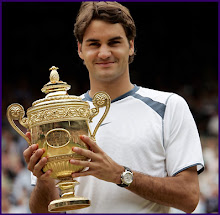Extensive hip rotation and a composed upper body make this shot a dependable asset.
The great thing about Novak Djokovic’s game is how complete it is. He can do pretty much anything. And while his forehand is a punishing stroke, his backhand might be the more solid of the two shots. Djokovic can hit the ball crosscourt or open up the court with a shot down the line. It’s a big part of his constantly improving game.
1. This is a classic preparatory position for a two-handed backhand. Djokovic is looking over his dominant shoulder to track the ball and has excellent balance and posture. His hands are slightly higher than his waist, with the racquet head above his wrists and pointed back and up at 2 o’clock. He’s behind the baseline, but Djokovic is giving himself ample opportunity to step into the shot.
2. Djokovic takes his racquet back by employing a full shoulder turn. It’s a fairly straight backswing with the racquet head up. It appears as though Djokovic is making a loop, but the position of his frame is a result of his full upper-body rotation. At this point, Djokovic plants his left foot and loads all his weight on it. He’s ready to start his forward swing.
3. Djokovic’s hands get more involved in the stroke as he raises them and increases his shoulder turn. He’s beginning to transfer his weight by stepping forward with his right foot, which is parallel to the baseline. (Ideally his foot would be at a 45-degree angle with the baseline to allow him to open up faster.) The thing to appreciate is the position of Djokovic’s hips. They’re fully rotated and coiled, and as the sequence continues he does a great job of releasing them into the shot.
4. As he gets ready to unleash on the ball, Djokovic points the butt cap of his racquet toward the other side of the net. He’s starting to drop his racquet head, but he’ll only get under the ball enough to give it a little bit of topspin. Djokovic is also pushing off the toes of his back foot and starting to open up his hips.
5. Djokovic makes contact in front of his body and at waist level. Notice how his hands are moving away from his torso and working together; neither is dominating the other. His legs are straightening to lift his body up into the shot, and his hips and shoulders are opening up. Djokovic’s shoulders are more uneven than usual, but that could be a slight improvisation to compensate for the ball’s height and position.
6. There’s so much momentum created by his racquet acceleration, trunk rotation, and the weight shift in his legs that Djokovic is off the court when he follows through. Even though he’s in full swing, his head and body remain composed. Djokovic’s arms extend through the hitting zone as his hips open up. His belly button, which was pointing to the side in his backswing, now faces the net.
7. Both of Djokovic’s elbows are pointing away from his body as he follows through. All his weight is now on his front foot, and his left leg is starting to come around to aid in his recovery. Djokovic has kept his head down throughout the stroke; only now is he tracking his shot. Judging the ball’s flight path and his opponent’s reaction will give Djokovic a better idea of where to position himself for his next shot.
8. The ball has left the frame, but Djokovic is still completing his long follow-through. This is a great lesson for rec players—finish the swing first, then recover. Djokovic’s left leg is swinging out so he can plant it and move back toward the center of the court. He’s low to the ground, with his balance still perfect. That will help him explode to wherever the next ball goes.

